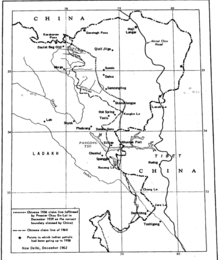Darbuk–Shyok–DBO Road
| Darbuk–Shyok–DBO Road | |
|---|---|
| Sub-Sector North Road | |
| Route information | |
| Maintained by Border Roads Organisation | |
| Length | 255 km[1] (158 mi) |
| Existed | April 2019–present |
| Major junctions | |
| From | Leh |
| Darbuk Shyok | |
| To | Daulat Beg Oldi (DBO) |
| Location | |
| Country | India |
| Districts | Leh district (Nubra) |
| Highway system | |


45km 30miles
Karakash
Chip Chap River
Jeong Nala
Raki Nala
Galwan River
Chang Chenmo
Shyok River
DBO
Track Jn.
Qizil Langar
Burtsa
Murgo
Sultan Chhushku
Mandaltang
Mundro
Chhumed
Shyok
Darbuk  Darbuk–Shyok–DBO Road[a] | |
The Darbuk–Shyok–DBO Road (DS-DBO Road/DSDBO Road), also called the Sub-Sector North Road, is a strategic all-weather road in eastern Ladakh in India, close to the Line of Actual Control with China. It connects Ladakh's capital city Leh, via the villages of Darbuk and Shyok at southern Shyok River Valley, with the Daulat Beg Oldi (DBO) post near the northern border. The 220-km long section between Shyok and DBO was constructed between 2000 and 2019 by India's Border Roads Organisation (BRO). The DS-DBO Road has reduced the travel time between Leh to DBO from 2 days to 6 hours.[1][2][3] In January 2023, BRO announced that it is constructing the DSDBO tunnel on this route.[4]
History[edit]
The Darbuk–Shyok–DBO Road traverses the historic winter route, also called the Zamistānee route, used by the trading caravans between Leh and Yarkand. Whereas the summer route would cross the Ladakh Range through the difficult Sasser Pass to reach the Shyok River valley, the winter route used to go via the banks of the Shyok River when the water flow would be much reduced and the frozen river surface could be crossed on foot as needed.[5][6]
Proceeding on the right (western) bank of the Shyok River up to Sultan Chhushku, the route crossed the river to the eastern bank, and followed the valley of Murgo Nala to reach the village of Murgo. Here, the summer route also joined the winter route after crossing the Shyok River near Saser Brangsa. From here, the joint route followed Burtsa Nala and Depsang Nala to reach the Depsang Plains and went on to the Karakoram Pass via Daulat Beg Oldi.[b]
Route[edit]
The BRO road begins near the village of Shyok, which is the on the west bank of the Shyok River after its V-shaped bend. Shyok already has roads leading west, to Leh via Darbuk, and south, leading to Pangong Tso. The BRO road crosses the Shyok river to its right bank and rounds the corner, continuing along its right bank due north (on the west side of the river bed).
After passing the historic campsites of Chhumed, Mundro and Mandaltang, it crosses the river near Sultan Chhushku. A 430-metre-long bridge over the full width of the river bed has been constructed and named the 'Colonel Chewang Rinchen Setu'.[c]
After the Setu, the road goes through the valley of Murgo Nala to reach the village of Murgo, then the valley of Burtsa Nala to reach the camping site of Burtsa, and then Depsang nala to pass by Qizil Langar, close to the Line of Actual Control with China. After Qizil Langar, the road enters the Depsang Plains on a more or less straight route to the Dault Beg Oldi.[9]
Sino-Indian border dispute[edit]

Near Burtsa, where the Depsang nala joins the Burtsa Nala, the Line of Actual Control has been disputed by China and India.[d]
China's 1956 claim line as well as the 1960 claim line leave the entire Burtsa Nala (Tiannan river in Chinese nomenclature) in Indian territory.[10] However, the People's Liberation Army's papers are said to document a so-called "line of actual control on 7 November 1959" which runs within an earshot of the DS–DBO Road.[11] Since 2013, they began to assert this line as the operative LAC.[12] The Chinese claim that they reached their line in 1962 and withdrew 20 kilometres as part of ceasefire, but the area was "unjustly occupied by India" in later years.[12]
During the border standoff in 2020, the Chinese forces again stationed themselves near a location called "Y-junction" or "bottleneck" in the Burtsa Nala valley, and blocked the Indian troops from patrolling to the east of it. China was claiming 250 square kilometres of new territory that India was previously accessing, while also posing threat to the DS-DBO Road.[13][14]
Construction: 2000-2019[edit]
The construction was initiated in 2000, with a revised deadline of 2014. However, in 2011, an inquiry by the Chief Technical Examiner found that three-quarters of the road had been laid on the river bed, which is unsuitable for military use. A new Border Roads Task Force from Jammu was then commissioned to realign the constructed road on higher ground and to complete it. The revamped project was scheduled for completion in 2017 but was eventually completed in April 2019. The old alignment was used in the intervening period during the winter months.[15]
Upgrades - DSDBO Tunnel: 2023 - present[edit]
DS-DBO Tunnel (DSDBO Tunnel), is being constructed by the BRO on DS-DBO route. It was announced in January 2023, when it was in the DPR (detailed project report) stage.[4]
Tourism[edit]
Murgo, along this road, has the Murgo Hotspring,[16] Murgo_Gompa|Murgo Gompa of Drukpa Kagyu lineage,[17] remnants of 400 years old breastwork fortification wall (fortification of earthwork piled up to breast height to provide protection to defenders shooting over it from a standing position) built by the governor of Nubra against the invasions from Tibetan Yarkent Khanate,[16] ancient skeletal remains of mules and camels as well as the partially decomposed ancient human bodies. The camels were brought here by the Yarkandi invaders.[18]
Burtse area along this road is a site of 40 million years old marine fossils when this area was in the Tethys Sea. The fossils found here include the gastropods (snail-like mollusks), bivalves (shellfish) and foraminifera (mostly microscopic organisms).[19]
See also[edit]
Notes[edit]
- ^ The border is marked by the OpenStreetMap editors and may not be accurate.
- ^ The summer caravan route is marked on the map provided by Maj. Gen. Vombatkere.[7]
- ^ The bridge has been named after a hero of Ladakh, Chewang Rinchen, who organised the Ladakhi resistance to the Gilgit Scouts invasion during the Indo-Pakistani War of 1947. He received Maha Vir Chakra, India's second highest military honour, twice in his life time.[8]
- ^ The terminology varies. Some writers refer to Raki nala that joins from the east as "Burtsa nala" as well. The Chinese call the river "Tiannan".
References[edit]
- ^ a b Ajay Banerjee, India completes vital Ladakh road Archived 9 June 2020 at the Wayback Machine, The Tribune (Chandigarh) 22 April 2019.
- ^ Nirupama Subramanian (16 June 2020). "Explained: The strategic road to DBO". The Indian Express. Archived from the original on 11 June 2020. Retrieved 12 June 2020.
- ^ Lt Gen Prakash Katoch, DSDBO Road completed – but what of the scam and the northeast? Archived 20 June 2020 at the Wayback Machine, Indian Defence Review, 27 April 2019.
- ^ a b भारत और चीन के बीच तवांग में हुए संघर्ष के बाद बॉर्डर रोड ऑर्गेनाइजेशन का प्लान 2023. Archived 28 January 2023 at the Wayback Machine, Navbharat Times, 4 Jan 2023.
- ^ Hayward, G. W. (1870), "Journey from Leh to Yarkand and Kaghgar, and Exploration of the Sources of the Yarkana River", The Journal of the Royal Geographical Society: 33
- ^ Warikoo, K. (2009), "India's gateway to Central Asia: trans-Himalayan trade and cultural movements through Kashmir and Ladakh, 1846–1947", in Warikoo, K. (ed.), Himalayan Frontiers of India: Historical, Geo-Political and Strategic Perspectives, Routledge, p. 1, ISBN 978-1-134-03294-5: "Those traders and passersby who opted to travel to Yarkand in winter would cross Digar La and follow the narrow and winding valleys of the Shyok river. This river, which was frozen during winter, was to be crossed and re-crossed several times."
- ^ Maj Gen S. G. Vombatkere, A Ring-Side View Of The Chinese Incursion Archived 2 November 2020 at the Wayback Machine, Countercurrents.org, 7 May 2013.
- ^ PTI, India's Highest Altitude All-weather Permanent Bridge Inaugurated by Rajnath Singh in Eastern Ladakh Archived 4 August 2020 at the Wayback Machine, News18, 21 October 2019.
- ^ Kapadia, Harish (2001), "The High Altitude Golf Courses", The Himalayan Journal, archived from the original on 24 June 2021, retrieved 11 September 2020
- ^ Hoffmann, Steven A. (1990), India and the China Crisis, University of California Press, MAP 5. Chinese claim lines of 1956 and 1960 in the Western Sector (p. 93), ISBN 978-0-520-06537-6
- ^ Hoffmann, Steven A. (1990), India and the China Crisis, University of California Press, MAP 6. India's forward policy, a Chinese view. (p. 105), ISBN 978-0-520-06537-6
- ^ a b Yun Sun, China’s Strategic Assessment of the Ladakh Clash Archived 10 September 2020 at the Wayback Machine, War on the Rocks, 19 June 2020.
- ^ "China Gained Ground on India During Bloody Summer in Himalayas". Bloomberg News. 1 November 2020. Archived from the original on 15 February 2021. Retrieved 10 October 2023.
- ^ Swami, Praveen (24 June 2020). "As PLA Seeks to Cut Off Indian Patrol Routes on LAC, 'Bottleneck' Emerges as Roadblock in Disengagement". News18. Archived from the original on 25 June 2020. Retrieved 26 June 2020.
- ^ Singh, Sushant (4 June 2015). "Constructed on the riverbed, the road to China border being rebuilt". The Indian Express. Archived from the original on 8 June 2020. Retrieved 25 May 2020.
- ^ a b Harish Kohl, 2000, Across the Frozen Himalaya: The Epic Winter Ski Traverse from Karakoram to Lipu Lekh Archived 22 September 2023 at the Wayback Machine, page 75.
- ^ Prem Singh Jina, 2009, Cultural Heritage of Ladakh Himalaya, p 114.
- ^ Harish Kapadia, 1999, Across Peaks & Passes in Ladakh, Zanskar & East Karakoram Archived 23 September 2022 at the Wayback Machine, p 116.
- ^ Geologist finds marine fossils at icy heights in Ladakh Archived 3 October 2023 at the Wayback Machine, Hindustan Times, 30 aug 2023.
Bibliography[edit]
- Hoffmann, Steven A. (1990), India and the China Crisis, University of California Press, p. 93, ISBN 978-0-520-06537-6
External links[edit]
- Prateek Joshi, India’s Growing Military Footprint in Eastern Ladakh: Facing China Archived 19 June 2020 at the Wayback Machine, CogitAsia, Center for Strategic & International Studies, 26 July 2016.
- Alice G Wells, Why Ladakh road built last year has been a thorn in China's flesh, Economic Timems Prime, 20 May 2020.
- "Amid Ladakh standoff with China, India puts border roads in fast lane". 2 June 2020.

